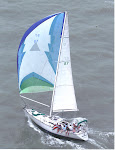The new engine arrived in
late August. We had paid for it at the end of May. Jan and I drove
out from Texas to Florida to help with the installation and do some
maintenance chores.
Al Blande from Al's Mobile
Marine was there with the shiny new motor. After three furious days
of labor the old motor and water heater were on the ground and the
new motor sitting in the engine compartment. There were two main
obstacles. The new motor (3JH5e) was about the same size as the old
one (3HM), but not quite. It was 100 pounds heavier, shorter, a bit
taller, and a lot wider. It would not fit through the lazerette
opening. The cockpit floor had to be opened which made the install
easy but left a gaping wound in the White Pepper.
The second problem was that the motor mounts were the perfect width
but lacked an inch fore and aft of fitting the old holes.
Furthermore, the motor needed to be lifted an inch to match the
transmission to the prop. Al arranged for stainless steel blocks to
be fabricated. These were expensive and would not be available until
after Labor Day.
Jan
and I drove to Texas with mixed emotions. Much work had been done,
but the job was not finished. Back in Texas I was able to land a
part time job for September and October. This job was helpful in
partially
paying for the project.
Also
back in Texas I had time to work on the propeller selection which is
the subject of another post. Of interest to anyone planning to re
power, it takes 6 to 8 weeks to have a Sailor brand propeller made by
Michigan Wheel. These are not off the shelf items!
During
this time Al had continued to work on the engine install and by
November only a few details were left undone. The big issue during
this period was wrestling a 3 inch exhaust system into the back of
the boat. This change was probably the most problematic of the
entire project. However, large exhaust systems are the future
because of environmental concerns being driven by Europe, mostly.
At
the end of October I resigned my job, we wrapped things up in Texas,
packed up the kitty and headed back to Florida for a rendezvous with
the Al, the propeller, and our White
Pepper.
Finally
all the pieces of the puzzle were put together. The last touch was a
shaft saver to guard against catastrophic failure of the prop at the
transmission and shaft alignment while in the water.
Sunday
dawned warm, gray and fairly calm. It was a good day for the sea
trials. The new engine roared to life. We pushed away from the dock
and headed out to the St. John's River. Al ordered 1500 revs per
second for five minutes and then upped the revs by 300 cycles per
second every 5 minutes. All the time he used his own instruments to
measure the revolutions per second and engine temperature compared
those to the actual reading on the instrument pod. The tachometer
was about 40 cycles per second too low and the thermometer was
reading about 8 degrees high. Both were within acceptable
parameters. Wide open throttle was 3200 per second and boat speed
was 7.7 knots. No smoke was seen and the motor did not seem to be
overloaded at WOT. After the WOT trial White
Pepper
cruised easily back to the dock at 7.2 knots while running at 2500
per second.
All
in all the morning was a remarkable culmination to a great deal of
expense and work. I was especially pleased that the boat had matched
and exceeded the expectations I had based on hours of calculation
back the the kitchen table at Beeville.
Jan
and I feel very confident about the upcoming cruising season. In
fact, today makes me think “what was I thinking?” trying to carry
on last year with such a crippled engine.

